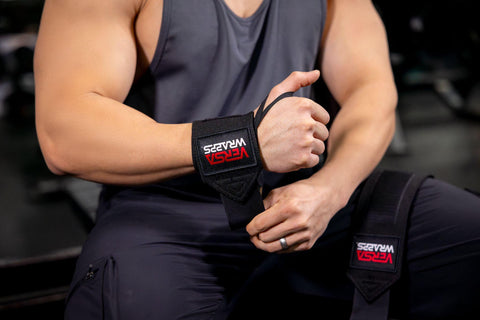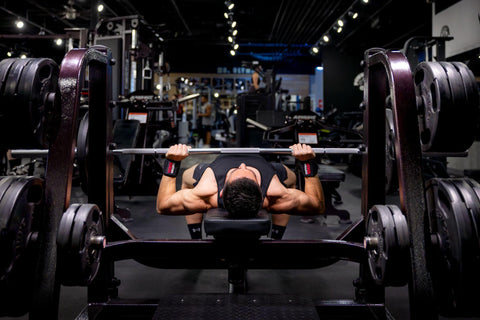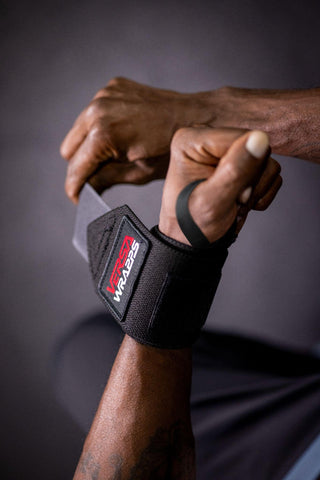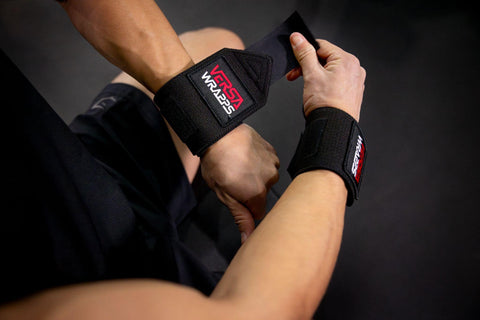May 16, 2025 5 min read

Weightlifting builds strength, boosts confidence, and transforms your body. Whether you’re just starting out or training for competition, every rep moves you closer to your goals.
But as the weight gets heavier, the demand on your body increases—and that’s where the right gear comes in. Tools like lifting belts, straps, hooks, and wraps are designed to support your form, protect your joints, and help you lift more efficiently.
With so many options out there, it’s hard to know what weightlifting gear is worth investing in and what to skip. Below, we’re zeroing in on weightlifting wraps: what they are, how they work, and how they can power up your performance.
Wrist wraps for weightlifters are designed to support your wrists during heavy lifts. They’re long, durable strips of fabric—usually made from a blend of synthetic materials and fabrics—that wrap snugly around your wrist joint.
When wrapped tightly, wrist wraps hold your wrist in a neutral position, helping you stay aligned during pressing, pushing, or squatting movements. This added structure reduces joint stress and lets your muscles handle the load more efficiently.

Wrist wraps offer several key benefits that can make a big difference in your training, especially as the weight gets heavier.
With consistent use during heavy training sessions, wrist wraps can help you push harder while protecting one of the most vulnerable joints in your upper body.
By locking your wrist in place, wraps keep your joints safe and stable. Wraps shift the load to your muscles, allowing them to work more efficiently. A secure wrist allows better force transfer through your upper body, improving control and reducing “energy leaks.”
Most wrist wraps are secured with Velcro and feature a thumb loop to help you get the right placement before tightening them down. They come in various lengths and stiffness levels, depending on how much support you need. Some lifters prefer more flexibility, while others go for maximum rigidity.
Whichever style you prefer, the main goal is the same: stabilize your wrists so you can safely work out with confidence. Keep in mind, though, that not all wrist wraps are created equal. The design, fabric, stitching, and materials all affect how well they’ll perform and how long they’ll last, so go with a product trusted by top athletes, like Versa Wrapps.

Knowing how to use wrist wraps for weightlifting properly will get you the best results. Follow these steps to get the most out of your wraps every time you train.
Now that you know how to wear a wrist wrap, here’s one more tip: Don’t overuse them. Wrist wraps are a tool, not a crutch. Take them off between sets or exercises to keep circulation flowing. This will help you get the support you need without causing issues with your joints or tissues.
Use wrist wraps during heavy pressing movements like bench presses, overhead presses, and push presses, especially when lifting 75+% of your one-rep max. They’re also great for low-bar squats and any lift where wrist stability is key.
By stabilizing your wrists and improving force transfer, wrist wraps can help you maintain better form and reduce discomfort. That extra support often gives you the confidence and control to push heavier loads.
Wrist wraps support your wrist joint during pressing or pushing movements. Lifting straps wrap around your wrist and the barbell and are used for pulling exercises like deadlifts and rows. Both wraps and lifting straps can improve your grip so you can focus on your form and lift heavier.
They should be snug enough to stabilize your wrist without cutting off circulation. If your hand feels numb or starts turning pale, loosen them. If they shift around or feel loose during a lift, tighten them slightly.
Yes, when used correctly. Wrist wraps help prevent hyperextension and reduce strain on your wrists, tendons, and ligaments. While they’re not a guarantee against injury, they add an important layer of protection during heavy training.
Avoid using wraps during light lifts, warm-ups, or mobility work. Your wrists need to move freely and build natural strength and flexibility. Overusing wraps in every workout can make your wrists overly dependent on support.

If you’re serious about support, it’s time to add Versa Wrapps to your training gear. Built with double-stitched construction, a secure finger loop, and a thoughtful design that prioritizes comfort and durability, Versa Wrapps give your wrists the stability they need to handle heavy loads.
They’re the perfect complement to Versa Gripps, our all-in-one solution that functions like hooks, straps, and gloves, all in a single product. Together, Versa Wrapps and Versa Gripps help you train harder, lift heavier, and get a safer workout.
Don’t settle for generic wrist wraps. Get Versa Wrapps and train better.
Copyright Versa Gripps 2025